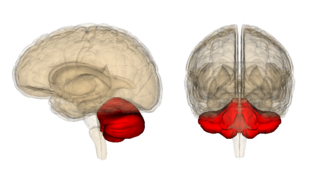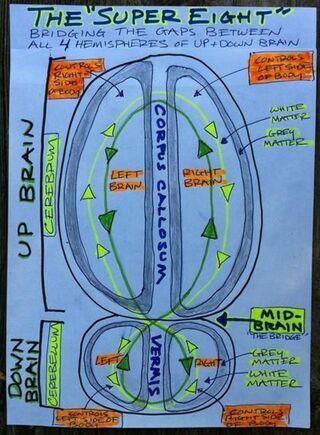Flow
How Cognitive Inflexibility Prevents Fluid Thinking
Cognitive flexibility—or lack thereof—is linked to cerebro-cerebellar circuits.
Posted July 18, 2021 Reviewed by Devon Frye
Key points
- Cognitive flexibility refers to thinking "outside the box" and connecting the dots between multiple concepts in new and useful ways.
- Cognitive inflexibility is a hallmark of autism spectrum disorders; a new study found this ASD trait is linked to cerebellar abnormalities.
- Optimizing cerebro-cerebellar circuits that connect the cerebrum and cerebellum may offset cognitive inflexibility and boost fluid thinking.

"Superfluidity" is a term I borrowed from the world of physics to describe a frictionless state of flow marked by absolutely zero viscosity or loss of kinetic energy when an athlete is really in the zone.
As an ultra-endurance triathlete and marathoner, I realized soon after reading Mihaly Csikszentmihalyi's seminal book, Flow: The Psychology of Optimal Experience, that I needed another word to describe episodic bursts of awe-inspiring fluidity that were more sublime than the everyday flow states I experienced by rote in my daily training. On this continuum, superfluidity is to flow as orgasm is to coitus.
When I retired from sports and became a writer, I realized while typing my first book's manuscript that during most 8-hour days of writing—when I was technically "in the zone" and my skill level perfectly matched the challenge—that my day's work might result in 2,000 words of usable content.
Notably, just like in sports, during my weekly process of trying to create flow states as a writer and optimize my creative thinking, there were episodic bursts of superfluidity at the keyboard when my brain seemed to completely "unclamp" and was able to operate without any friction or viscosity.
During these brief windows of extreme, turbo-charged cognitive flexibility at my typewriter, I might produce 6,000 words (three days' work) in one-third the time with significantly less mental effort. As a writer, it's become clear to me over the years that superfluid thinking is the antithesis of cognitive inflexibility.

Cognitive Flexibility: The Cerebellum May Coordinate Fluid Thoughts, Just Like It Coordinates Fluid Movements
During episodic bursts of superfluidity, I have a hunch that every part of the cerebrum and cerebellum coordinates like a well-oiled machine; the whole brain (all four hemispheres) works in concert to connect the dots between seemingly unrelated ideas in new and useful ways.
Almost every "Eureka. I've found it!" flash of insight that I've ever experienced has occurred in a superfluid flow state. These "Aha" moments usually happen when I'm jogging, which means I have to type the ideas into a text message and send it to myself on my smartphone, so I don't forget how the concepts are interconnected when my superfluidity subsides.
Because my late father was a neuroscientist who wrote The Fabric of Mind, I grew up looking at athletic and academic pursuits through the lens of cerebral ("book smarts") and cerebellar ("muscle memory") skill sets. For The Athlete's Way, Dad and I created a split-brain model that presented the cerebellum as key to creating automaticity, which promotes flow states and minimizes cerebral overthinking in sports and day-to-day life. (See, "Cerebro-Cerebellar Circuits Remind Us: To Know Is Not Enough.")
In terms of creating superfluidity on demand, the million-dollar question for me has long been, "How are the cerebrum and cerebellum working together to create frictionless flow states that are free of any viscosity?"

My Decades-Long Quest to Decode a Hand-Drawn Brain Map
Since 2009, I've been filtering any neuroscience-based research related to cerebro-cerebellar circuits through a brain map that I drew with some Sharpies and colored highlighters decades ago. In a recent post, I explained why solving the mysteries held in this brain map is like looking for a buried treasure or holy grail. New research is helping to decode this enigmatic map.
This week, researchers from the RIKEN Center for Brain Science in Japan published a paper (Balan et al., 2021) that sheds light on how atypical neurodevelopment of the cerebellum may be linked to autism-like cognitive inflexibility in "knockout" mice missing the SUV39H2 gene.
The recent RIKEN discovery of an association between cerebellar abnormalities and cognitive inflexibility reminds me of Jeremy Schmahmann's "Dysmetria of Thought" hypothesis, which posits that just like the cerebellum helps to coordinate fluid movements, it may also play a role in coordinating fluid thoughts in ways that promote cognitive flexibility.
Another recent study (Molendowska et al., 2021) suggests that mastering a new skill via "practice, practice, practice" can reorganize white matter in ways that change architectural microstructures and rearrange the brain's blueprints.
Taken together, the latest research suggests that finding ways to optimize the structure and function of white matter tracts and cerebro-cerebellar circuits that connect different gray matter regions throughout the entire brain could increase one's odds of avoiding cognitive inflexibility.
Much more research is needed to identify what interventions and daily lifestyle choices create brain changes that facilitate flow states and "superfluid" cognitive flexibility.
References
Shabeesh Balan, Yoshimi Iwayama, […]Takeo Yoshikawa, et al. ""A Loss-of-Function Variant in SUV39H2 Identified in Autism-Spectrum Disorder Causes Altered H3K9 Trimethylation and Dysregulation of Protocadherin β-Cluster Genes in the Developing Brain." Molecular Psychiatry (First published: July 15, 2021) DOI: 10.1038/s41380-021-01199-7
Malwina Molendowska, Jacek Matuszewski, Bartosz Kossowski, Łukasz Bola, Anna Banaszkiewicz, Małgorzata Paplińska, Katarzyna Jednoróg, Bogdan Draganski and Artur Marchewka. "Temporal Dynamics of Brain White Matter Plasticity in Sighted Subjects During Tactile Braille Learning - a Longitudinal Diffusion Tensor Imaging Study." Journal of Neuroscience (First published: July 12, 2021) DOI: 10.1523/JNEUROSCI.2242-20.2021
Anila M. D'Mello and Catherine J. Stoodley. "Cerebro-Cerebellar Circuits in Autism Spectrum Disorder." Frontiers in Neuroscience (First published: November 05, 2015) DOI: 10.3389/fnins.2015.00408
Jeremy D. Schmahmann. "Dysmetria of Thought: Clinical Consequences of Cerebellar Dysfunction on Cognition and Affect." Trends in Cognitive Neuroscience (First published: September 1, 1998) DOI: 10.1016/S1364-6613(98)01218-2




